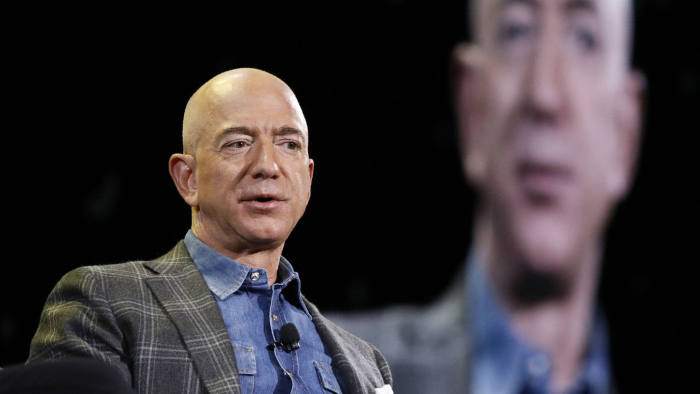
Amazon rejoins $1tn club on back of blockbuster earnings
Bezos empire alongside Apple and Microsoft after further share price gains
by Dave LeeAmazon’s market capitalisation has exceeded $1tn for the first time in over a year, on the heels of its blockbuster fourth-quarter earnings.
Jeff Bezos’s empire built on stock price gains of more than 10 per cent overnight on Thursday to rejoin Big Tech’s feted club, currently occupied by Apple and Microsoft.
Google parent Alphabet passed the $1tn milestone for the first time in January, but has since dipped below, while Amazon first hit it in September 2018 before similarly slipping back.
Amazon’s earnings over the festive period far surpassed analysts’ expectations when they were published on Thursday. The retailer exceeded revenue estimates, but it was strong net income that surprised investors most: $3.3bn versus a consensus of $1.97bn, according to data from S&P Capital IQ.
The company’s earnings were boosted by its new initiative to ramp up its infrastructure to offer one-day shipping on 100m products, which cost less than the $1.5bn it said it had anticipated. Subscriptions to Amazon Prime, the premium service that costs $119 a year in the US, surged in Q4 to over 150m globally as shoppers panicked their way through last-minute gift-buying.
“The number of items delivered to US customers with Prime’s free one-day and same-day delivery more than quadrupled this quarter compared to last year,” Mr Bezos said, also noting the popularity of other Prime benefits, such as two-hour grocery delivery and its Netflix-competing Prime Video service.
Other areas of Amazon’s business also outperformed. Its cloud computing arm, Amazon Web Services (AWS), had sales growth of 34 per cent, contributing two-thirds of Amazon’s overall operating income for the October-December period.
Recommended
Markets InsightJohn Plender
It’s a strange new world where tech stocks are safe havens
Meanwhile, an increase in third-party sellers reaching Amazon customers directly — without storing their goods at Amazon warehouses — is in turn boosting Amazon’s advertising business as those companies battle to reach shoppers’ eyeballs. Ad revenues were up 40 per cent year-on-year to $4.8bn, making it the fastest-growing part of the company’s business.
“Amazon is strongly positioned for the long term with unassailable competitive positions in its existing large and growing markets,” said Christopher Rossbach at J Stern. The retailer’s inroads into healthcare and brick-and-mortar shopping offer more significant growth potential, he said.
“Amazon has become a trillion-dollar-market-cap company again after these results and it has the prospects to become a two-trillion-dollar-market-cap company.”
Recommended
FT News Briefing podcast9 min listen
IBM new broom, Amazon delivers, Brexit day
So far, Wall Street appears unfazed by potential trouble ahead for Amazon in 2020. The company is currently being investigated over its competitive behaviour in both the US and EU, where regulators are closely examining the degree to which Amazon uses data collected from shoppers to give it an unfair advantage on its marketplace.
Some analysts also predict a tougher competitive landscape for AWS as other cloud providers increase their technical capabilities. In particular, Microsoft’s Azure platform, having secured a hotly-contested $10bn contract with the Pentagon, could stand to benefit if other US government services follow the military’s lead.
Amazon is currently suing over the contract, arguing that President Donald Trump interfered in the process owing to his personal dislike of Mr Bezos, who also owns the Washington Post.